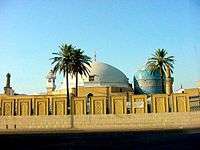Esad Erbili
Esad Erbili or Mehmed Esad Efendi was a shaykh of the Naqshi-Khalidi sufi order and brought a branch of the Naqshbandiyyah with him to Istanbul at the beginning of World War I.
Biography
Esad Erbili was born in Arbil in Iraq in the year 1847 (1264), where he studied under Taha al-Hariri. After the death of Shaykh al-Hariri in 1875 he visited Istanbul for a short time. He was exiled to Arbil in 1900.[1] Later returning in 1910 to established a Dergah (Tekke) in Üsküdar[2] Master M. Es’ad was rather tall, White bearded, had straining eyes, dark-skinned, smiling, endearmently and staid person. He had a very strong mind that he could know the person whom he talked years before, and he used to remember the topic they talked.
The 30th chain of the Golden Silsilah was again from Iraq, Arbil/Musul, was born in 1264/1847. He is “Sayyid” both from mother and father. His father is the Shaikh of Khalidî Tekke (lodge) in Arbil, named Master M. Saîd. His grandfather Master Hidayetullah is the khalifa where Mevlana Halid el-Baghdadi built the tekke in Arbil. After completing his first education in Arbil and Deyr, while he was 23 (in 1287/1847), with a spiritual point, he became affiliated with Naqshi-Khalidi Shaikh Taha’l-Hariri. He completed his spiritual evolve in 5 years and got caliphate. Then he went to Hijaz in 1292/1875.
Arriving Istanbul
Returning from Hajj, and having lost his Shaikh, he came to Istanbul. He stayed at “Besiraga Dargah” as a guest in Salkimsogut. After lovers and visitors of him increased a lot, he left there and settled the muezzin room of a mosque in Bayezid-Parmakkapi. He taught the “Khafiz Divan” and “Luccet-ul Asrar” of Mawlana Jamii in Fatih Mosque. Many people of knowledge and wisdom continued these lessons. Hodja Master Yekta and some other scholars recognized him in these lessons and became affiliated with him.
In a short time, his reputation encircled Istanbul and the son-in-law of the Sultan, Darwish Pashazade Khalid Pasha invited him to the Palace and learned Arabic and religious sciences from him. M. Es’ad Erbili was appointed to the member of Majles-I Mashayih by Sultan Abdulhamid Khan the second. He used to go to Majles during the meetings, to the Fatih Mosque for lessons and sometimes used to go to the Palace.
In the meantime, he moved his house to one of the rooms which are over the gates of Bayezid Mosuqe. Moreover, he appealed for a “tekke”. At that time, “Kadirî Dargah” was free. Because this place is of a Kadirî Dargah, the Sheikh should have a Kadirî diploma (permit). Master M. Esad was appointed to this dargah after having diploma from one of the grandchilds of Abd el-Kader Gîlānî, named Abdulhameed er-Refqanî. There he first made Kadirî ritual and afterwards he made “Hatm-I Hacegan”
Assembly of Shaykhs
In 1914, Esad Erbili was appointed the chairman of the Assembly of Shaykhs[3] (The Council of Islamic Teachers, or Meclis-i Meşâyıh) in Istanbul and was so until its closure in 1915[2]
Menemen Incident
As part of the Atatürk's Reforms, the tekke in Istanbul was closed. He was captured with his son Mehmed Efendi because they were thought to be involved in the 1930 Menemen Incident. Esad Efendi was initially sentenced to death, later his penalty was reduced to life in jail because of his age[4][5] and he was poisoned and died shortly afterwards in a Military Hospital in Izmir.[2] The following couplet of him is considered as an oracle that he perceived that he will be martyrized:
"How possible it is to ablution the martyr with that much fire who was martyrized by burning with love? The body is fired, the shroud is fired, and also the water that is pouring out is fired".
Writings
- Kenzul-Irfan-Translation and Commentary of 100,000 Hadith
- Maktubat (Mektubat) [6] - a collection of letters to his students
- Divan - Turkish and Persian Poetry
- Risale-i Es'adiyye - Autobiography
- Tevhid Risalesi Tercümesi - A Commentary of Ibn Arabi's Kitab al-Tawhid
- Fatiha-i Şerife Tercümesi - A tafsir (commentary) of the first chapter of the Qur'an
Notes
- ↑ Türkiye Ekonomik ve Toplumsal Tarih Vakfı, Dünden Bugüne İstanbul Ansiklopedisi, Kültür Bakanlığı, 1994, ISBN 978-975-7306-06-1, p. 37. (Turkish)
- 1 2 3 Yilmaz, H. Kamil:"Altin Silsile" ("Golden Chain"). Erkam Yayinlari (Istanbul). 1994.
- ↑ Brian Silverstain, "Sufism and Modernity in Turkey: From the Authenticity of Experience to the Practice of Discipline," in M. van Bruinessen and J. Day Howell, eds. Sufism and the Modern in Islam, I.B. Tauris, 2007, ISBN 978-1-85043-854-0, p. 39.
- ↑ Mustafa Armağan, "Menemen olayında 10 büyük şüphe", official personal webcite of Mustafa Armağan. (Turkish)
- ↑ Touraj Atabaki, The State and the Subaltern: Modernization, Society and the State in Turkey and Iran, I.B.Tauris, 2007, ISBN 978-1-84511-339-1, p. 131.
- ↑ Muhammad Esat Erbili: "Mektubat" ("Letters"). Erkam Yayinlari (Istanbul)
